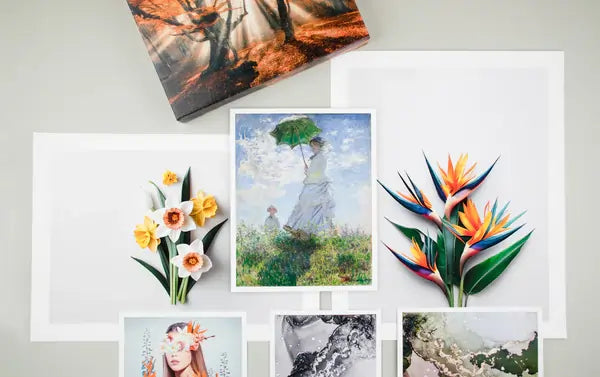TL;DR: Giclee Printing
Giclee is a museum-quality inkjet print process that uses archival pigment inks on archival paper or canvas to produce high-detail, color-accurate prints that hold up for decades with proper care.
- Best for: selling art and photography, galleries, exhibitions, editions, and premium client work.
- What makes it different: pigment ink, calibrated color workflow, and archival materials.
- Decide first: paper vs canvas, finish/texture, size, and whether you want a border for framing.
- Pro move: order a small test print before a large piece or a full edition run.
Jump to: Papers and Canvas, File Requirements, Why It Costs More.
What is Giclée Printing?
Giclée printing is one of the best choices for artists and photographers who want to create gallery-quality reproductions of their work. In short, giclée printing is the process of using professional inkjet printers with archival-quality inks to produce prints on a variety of archival media types, such as fine art papers and canvas. This method is favored for its ability to capture even the most subtle details and tonal variations. This makes sure that the final print closely matches the original artwork or photograph.
Because of its precision and durability, giclée printing is widely used by galleries, museums, and collectors for exhibitions, limited edition runs, archival purposes, and much more. The result is a print with true-to-life color, exceptional richness, and long-lasting quality that can endure for decades without noticeable fading when properly cared for.
So what exactly is meant by “giclée printing”? What is the difference between a print and a Giclée print? In this guide, we’ll answer common questions about the process. We’ll cover materials, techniques, archival standards, and display options. Having these answers in hand should help you determine whether giclée printing is the right fit for showcasing your creative work.
Giclee Printing Quick Answer
Giclee printing is a high-end inkjet printing method that uses archival pigment inks and archival papers or canvas to create museum-quality prints with excellent color accuracy and long display life.
- Best for: artists, photographers, galleries, and collectors who want premium prints.
- What makes it different: pigment inks, calibrated color workflow, and archival media.
- What to decide first: paper vs canvas, finish, size, and border.
Want to jump straight to materials? Visit Papers and Canvas: How to Choose.
What is a Giclée Print?
Definition: Giclée comes from the French gicler, “to spray.” It’s a high-quality digital printing process that uses professional inkjet printers to lay down millions of tiny droplets of archival pigment ink on archival papers or artist-grade canvas.
Need your original scanned first?
A bit of history: In the early 1990s, printmaker Jack Duganne created the term “giclée.” Photographers like Graham Nash helped kick off the movement by modifying Iris inkjet printers to print on thicker materials.
How Do You Pronounce Giclée?
The word Giclée is pronounced zhee-clay, with the soft “zh” sound at the beginning, like the “g” in genre.
Why Artists and Photographers Choose Giclée
Serious artists and photographers keep coming back to giclée because of the unmatched combination of detail, color accuracy, and longevity.
- Exceptional detail: High resolution preserves fine lines, textures, and gradients.
- Longevity: Archival pigment inks and substrates are designed for very long display life.
- Consistency: Calibrated workflows mean repeatable results across editions.
- Business friendly: Ideal for selling limited editions, fulfilling online orders, and building a professional portfolio.
Longevity & display care tips
See customer results
Get free paper samples
Fine Art vs. Photographic Printing
Fine art (giclée) uses archival pigment inks on acid-free papers or canvas for museum-grade longevity and color fidelity. Photographic prints use light-sensitive RC papers and chemistry for a sleek, glossy look designed for everyday display.
- Fine Art / Giclée: archival media, wider gamut, textured or matte options, ideal for editions and collector sales.
- Photographic: smooth RC surfaces (luster, glossy), fast turnaround, great for portfolios and décor.
Compare media in our Media Guide or order a Free Media Sample Set.
Giclée vs. Other Print Types
Not all prints are created equal.
If you’re trying to decide between giclée prints, standard photo prints, or traditional printmaking, this section will help.
Giclée vs. Standard Photo Prints
| Feature | Giclée Prints | Standard Photo Prints |
|---|---|---|
| Ink | Archival pigment | Dye or photographic chemistry |
| Media | Archival fine art papers, artist-grade canvas, and RC photo papers | RC photo papers |
| Look | Smooth tonal transitions, museum-grade finish | Punchy, everyday display look |
| Longevity | Very high with proper care | Moderate |
| Best for | Fine art sales, exhibitions, portfolios | Bulk runs, décor, promo |
Giclée vs. Traditional Printmaking
- Lithographs / screenprints: Handcrafted, limited runs with their own unique look.
- Giclée: Digital reproduction designed to match the original’s color and detail closely.
What Makes Giclée Prints Cost More?
You are paying for:
- Archival materials that resist fading and deterioration.
- Advanced printers that place microscopic droplets with extreme precision.
- Pigment inks that are colorful and long-lasting.
How Long Do Giclee Prints Last?
Giclee prints are designed for long display life because they use archival pigment inks and archival papers or canvas. With proper care, they can remain vibrant for decades.
How to Make Your Prints Last Longer
- Keep prints out of direct sunlight and away from high humidity.
- Use archival framing materials and UV-protective glazing when framing.
- Handle prints with clean, dry hands and avoid touching the print surface.
For a full care guide: How to care for your prints.
Technology & Standards at The Stackhouse
- Printers: Epson SureColor class with UltraChrome PRO12 12-color ink-sets and high-precision printheads.
- Papers: Premium quality papers and canvas manufactured by Epson and Hahnemühle.
- Workflow: Calibrated color management, white-glove handling, and protective packaging.
How Fine Art Prints Are Made
- Prepare your file: TIFF/JPEG/PNG, ~300 PPI at final size, Adobe RGB (1998) or sRGB. Profile tips
- Calibrate & preview: use a calibrated monitor; confirm white/black points and crop.
- Proof: print a small test to verify color, tone, and paper choice.
- Print & finish: print on selected media, trim, inspect, package.
Need digitization first? Artwork Scanning.
File Requirements for Giclee Prints
If your file is not set up correctly, even the best printing process cannot save it. Use this checklist to make sure your artwork prints clean, sharp, and true to color.
- Resolution: Aim for 300 PPI at final print size. For large wall art, 200–300 PPI can still look excellent at normal viewing distance.
- File types: TIFF (best), PNG, or high-quality JPEG.
- Color space: Adobe RGB (1998) or sRGB. If you are unsure, sRGB is safest.
- Sharpening: Avoid heavy sharpening. Fine art papers can exaggerate halos and crunchy edges.
- Borders: If you plan to frame, leave room for a mat or border so important details are not covered.
For a deeper walkthrough: Best file formats for printing and ICC profile and color tips.
Borders, Bleed, and Cropping
Before you order, decide how the print will be displayed. Framing, matting, and trimming all change what is visible, especially near the edges.
When to Add a Border
- Add a border if you plan to frame or mat your print, or if you want breathing room around the art.
- Go borderless if the artwork is designed to run edge-to-edge or you are mounting the print.
How to Avoid Unexpected Cropping
- Keep key details away from the edges so trims and mats do not cut into important elements.
- If your image is not the same aspect ratio as your chosen size, you will either crop the image or leave extra border space.
- If you are unsure, start with a small test print first.
Need help choosing sizes and margins? Start here: How to print your art.
Papers and Canvas: How to Choose
Your choice of paper or canvas can transform the look and feel of your artwork. Here’s how to match your creative style to the right archival media.
Shop by material:
Fine Art Papers
Canvas
Photo Papers
Fine Art Papers (Giclée)
From smooth cotton to textured watercolor surfaces, discover the qualities of each fine art paper so you can make an informed choice.
| Paper | Surface | Weight / Thickness | Base | Best For |
|---|---|---|---|---|
| Hot Press Bright (Epson) | Smooth matte, bright white | 300 gsm / 16 mil | 100% Cotton Rag | Illustrations, clean lines, high detail |
| Cold Press Bright (Epson) | Textured matte, bright white | 305 gsm / 19 mil | 100% Cotton Rag | Watercolor textures, painterly work |
| Photo Rag (Hahnemühle) | Velvety matte | 308 gsm / 18.9 mil | 100% Cotton Fiber | Fine art photography, rich midtones |
| William Turner (Hahnemühle) | Distinct watercolor texture | 310 gsm / 24.4 mil | 100% Cotton Fiber | Traditional media reproductions |
| FineArt Baryta (Hahnemühle) | Glossy baryta finish | 325 gsm / 16.14 mil | Alpha Cellulose | Deep blacks, high-contrast photography |
Canvas Options (Giclée)
Canvas offers a timeless, tactile, and ready-to-display presentation. Here’s how satin and matte canvas compare.
| Canvas | Finish | Best For |
|---|---|---|
| Satin Canvas | Subtle sheen, enhanced vibrancy | Colorful artwork and photographs |
| Matte Canvas | Non-reflective, classic look | Traditional paintings, subdued palettes |
Giclée Photo Papers
Not every project calls for textured fine art papers. For vibrant photography, marketing prints, or contemporary artwork, our giclée-grade photo papers deliver exceptional color and sharpness while still offering archival quality.
| Paper | Finish | Weight / Thickness | Type | Best For |
|---|---|---|---|---|
| Luster Photo Paper | Luster (orange peel) | 260 gsm / 10 mil | Resin Coated | Portraits, landscapes, and images needing reduced glare with rich colors |
| Glossy Photo Paper | High gloss | 250 gsm / 10 mil | Resin Coated | High-impact images with vibrant color and sharp detail |
| Metallic Glossy Photo Paper | High-gloss pearlescent | 255 gsm / 10.4 mil | Resin Coated | Images needing a luminous, dimensional quality |
| Photo Matte Fibre | Natural white matte | 200 gsm / 11.8 mil | 100% Alpha-Cellulose | Soft, non-reflective look for both color and black-and-white prints |
Common Problems Giclée Solves
Color shifts, loss of detail, fading issues plague many prints. Giclée is designed to solve them. Here’s how.
- Color mismatch: More inks and profiling deliver accurate color.
- Lost detail: Fine linework and textures hold up at size.
- Premature fading: Archival inks and media increase display life.
Is Giclée Printing Right for You?
Not every project needs the museum-grade treatment. This section helps you decide if giclée is the best fit for your goals.
Choose giclée if you are:
- An artist or photographer selling premium prints or preparing for gallery shows.
- A collector or institution that needs faithful, long-lasting reproductions.
- A brand or studio that wants museum-grade quality for clients.
If you need bulk, lowest-cost runs for short-term use, photo prints may be a better fit.
Try a small test print to preview color and paper behavior before a full run.
Print-on-Demand and Dropshipping
Skip the bulk orders and ship directly to your customers. See how our POD and dropshipping options keep your business lean and efficient.
- No minimums and on-demand fulfillment
- Third-party fulfillment for online shops and marketplaces
- Consistent quality control across orders
Frequently Asked Questions
If you care about accurate color, fine detail, and long-lasting quality, giclee is worth it. It is a popular choice for artists selling premium work, galleries, and collectors.
No. Giclee typically refers to high-end inkjet printing using archival pigment inks, calibrated color workflow, and archival media. Many consumer inkjets do not meet those standards.
It depends on the artwork. Smooth cotton papers are great for crisp detail, textured papers work well for painterly pieces, and baryta papers are ideal for deep blacks and high-contrast photography.
Yes. A small test print is the quickest way to check color, paper texture, and detail. This helps before you decide on a large size or a full edition run.




